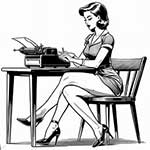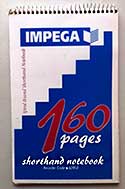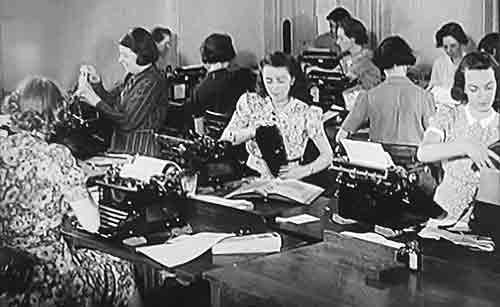The shorthand-typist: a common women’s job before the computer age

A shorthand-typist was someone, usually a woman, who used shorthand to take dictation of letters and other documents and then typed them. This was before the development of dictation and word-processing software which enabled people to do their own typing. This page explains. It also describes the training of shorthand-typists and elaborates on their work with special reference to the 'typing pool' which was widespread and essential in large organisations.
____
By the webmaster, based on discussions with and written records from shorthand-typists in the 1950s
What shorthand-typists were
A shorthand typist was someone, usually a woman, who used shorthand to take dictation of letters and other documents and then typed them. Shorthand-typists were not generally responsible to any one man - yes, almost always at man - and they tended to work in a pool with other shorthand-typists, although there were exceptions - more of which below.
Whenever a man wanted a letter sent, a shorthand-typist would be called into his office, notebook and pencil in hand, and he would dictate the letter at normal speech speed. She wrote it down in what was known as 'shorthand', and took it away to type on her manual typewriter.
Shorthand-typing was regarded as a job rather than a career because the girls - not women - were expected to leave and get married. Sexism was rife in offices at the time.
Training for shorthand-typists
Training as a shorthand-typist took a year after leaving school, usually at the local technical college. There was no shortage of places, just as there was no shortage of jobs for shorthand-typists.
There were several versions of shorthand, and although I never learnt one as I never was a shorthand-typist, I am full of admiration for those who did. It seemed and still seems very difficult to me, although numerous women managed it. Once out of college, I understand that they soon adapted their shorthand with their own shortcuts and admitted that no-one else would be able to read it back.
The typing was 'touch-typing' which meant that the typist was not to look at the keys while she typed. This was so that she could keep her eyes on her shorthand notebook - spiral bound at the top so that pages could be flipped over quickly, so not interrupting the note-taking.

A shorthand notebook, spiral bound at the top for rapid page turning
contributed by Freda Cryer, recollection
After a few weeks, my training began at the keyboard and my hands were covered with a cloth so that I had to work by feel. There must of course have been other methods.
The skill of a typist was measured in terms of how many words per minute she could type.
I did teach myself to touch type from a book in the 1960s and the skill has been extremely useful to me, now that computer keyboards have replaced typewriters. In my view, in this digital age, touch typing ought to be taught in schools as a compulsory subject for both sexes.
The need for shorthand-typists in the 1950s
Before the digital age which led to professional men typing their own letters and documents, they always had shorthand-typists to type for them. Men would never type their own letters! They were not expected to know how, and it would have been beneath their dignity anyway.
The typing pool and what it was like to work in one
Typing pools were rooms of shorthand typists who were on call to work for anyone in the organisation who needed something typed. They were always busy places.

A typing pool. Screen shot from an old film.
Experiences of the typing pool
contributed by Sue Beer, recollections
When I started work at a big construction company in Leicester Square, I was in a typing pool. There was a manager sitting at the front of the large office in which we sat in rows (all girls, of course), almost exactly like school. She allocated jobs when the (all male) drawing office needed help, and we'd be sent down there.
When taking the shorthand, we girls had to sit on high stools just like the drawing office blokes but in our tight short skirts and high heels. We were so embarrassed. Then, when we finished taking dictation, we had to shuffle off our stools and walk out, often with 20 pairs of eyes watching our reverse ... horrible. In a horrible and cynical way, it's quite entertaining to hear all the uproar nowadays about sexual harassment in the past. I and all women I knew thought that it was completely normal, from that very low-level stuff from the draughtsmen, knowing how shy and uncomfortable we all were, to being physically groped on over-full tube trains. No-one ever talked about it.
Back to the typing pool: We were allocated a time to visit the lavatories, right to the actual minute, woe betide you if you missed your slot.
Correcting and finalising typed letters and documents
Once a short-hand typist had typed the letters or documents, she normally placed them inside a hard-covered book, designed for the purpose, with each document separated by a page. This book was presented to the man who instigated the dictation, who checked everything and signed the letters.
If he had second thoughts, an entire page often had to be retyped. With single letter corrections, though, he marked them with a soft pencil that could be rubbed out. There were special strips of white-coated paper that could be pressed over incorrect words to cover them and effectively erase them. There was also a white masking fluid called Tipp-ex or Snowpake that could be painted on, which dried on the paper.
Once the wrong letter had been erased, the correct one had to be typed on top. It was normally near impossible to align the document precisely in the typewriter. So the new letter was never quite in line with the rest of the typing, but no-one seemed to be particularly critical because these mistakes were so common.
Secretaries - not shorthand-typists
Career progression for a shorthand-typist, if it existed, was to become a secretary.
A secretary was trained in shorthand-typing and often a promoted shorthand-typist, but she had a more responsible role and was better paid. She was expected to answer phones, file, keep diaries, and be at the beck and call of her boss. Much the same job exists today but the job title has changed to Personal Assistant or Administrator.
| sources | webmaster | contact |
Text and images are copyright
If you can add anything to this page or provide a photo, please contact me.



